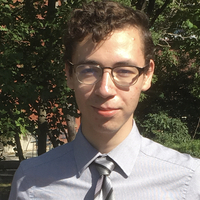Radial displacement assay distinguishes ALA from RIS mutants during recovery from heat stress in Caenorhabditis elegans
The study of sleep is an emerging and incomplete field of research. Animals are observed to sleep when sick as a mechanism to aid recovery. The Raizen Lab focuses on understanding the molecular pathway responsible for Stress/Sickness-Induced Sleep (SIS) in C. elegans. Stress-inducing events (UV irradiation, viral infection, high temperatures, etc.) cause the release of Epidermal Growth Factor (EGF) via an unknown process which activates EGF receptors (Hill, et al 2014) in the ALA and RIS neurons. After activation, the neurons release their respective neuropeptides which effectuate an unknown downstream cascade to promote sleep.
It has been observed that two mutant strains that lack the ALA and RIS neurons (ceh-17 and aptf-1 respectively) exhibit a defect in movement quiescence but vary in their phenotype. ceh-17 are able to move their entire bodies after stress while aptf-1 can only move their noses. The lab’s usual machine vision method used to quantify quiescence is not able to detect the difference between these two types of movements (Raizen lab, unpublished observations). Thus, I spent the last two semesters developing a radial dispersion assay that could distinguish between the phenotypes of the two strains.
In short, circular agar plates were seeded with an E. coli ring along the periphery. Then, wild type, ceh-17, or aptf-1 worms were pipetted unto the geometrical center of the plates. The plates were subsequently submerged in a high temperature water bath to induce sickness. I found that wild-type worms remain close to the middle of the Petri dish after heat shock. This is presumably because they are sick. In contrast, I found that ceh-17 mutants (in which the ALA neuron is defective) crawled to the bacteria immediately after heat shock. aptf-1 mutants, while deficient in movement quiescence due to RIS neuron dysfunction, stayed near the center of the Petri dish and were very slow to reach the bacterial food. We are planning on submitting a manuscript for a micropublication on this project this year.
This assay opens multiple possibilities that may help develop our understanding of the Stress/Sickness Induced Pathway (SIS). For example, it may serve as a tool to categorize known sleep-defective mutants into ALA or RIS-deficient based on phenotypes. This assay can also be expanded to measure motivation-based behavior during sickness. Studying this process in worms can give us insight into understanding the molecular basis of human fatigue.

Comments
Novel Test
The new differentiation technique between C. elegans mutants was very interesting, especially set within the realm of sleep and the wider implications of quiscence in animals. Carlos' passion is veritably palpable, and really shows in his pitch and discussion. Very knowledgeable about the subject matter.
I wish Carlos and the Raizen lab the best of luck in their future endeavours in furthering sleep and C. elegans scientific literature.
Very Promising
Carlos' research offers new insight into the analysis of a new assay. His research on sleep offers a promising future for the behavioral analysis of human sleep cycles. Great Job!
Presentation
Carlos gave a great presentation and his knowledge on the subject was very impressive. His passion is admirable.
ALA and RIS
Is ALA and RIS different pathway or just two distinct genes sequences?
Re: ALA and RIS
Thank you for your question,
The ALA and RIS neurons are separate branches of the Sickness-Induced pathway. The two neurons are encoded by two different genes, ceh-17 and aptf-1.